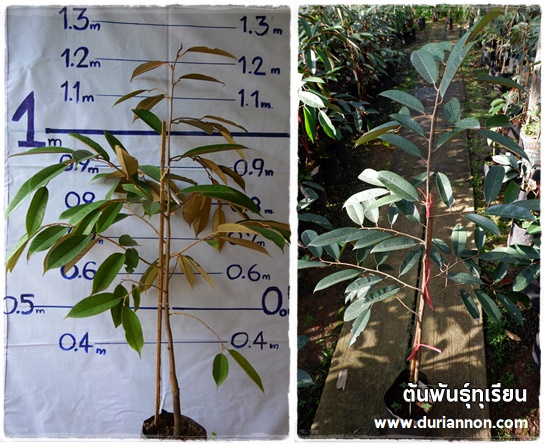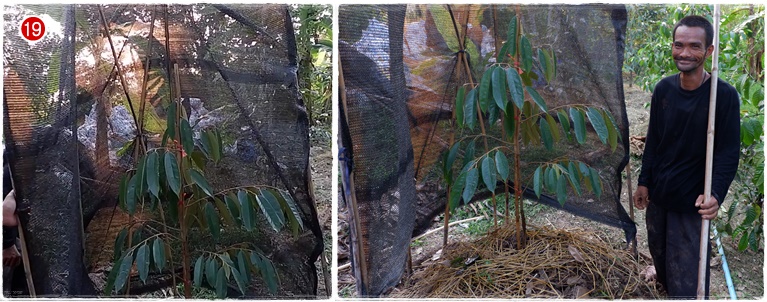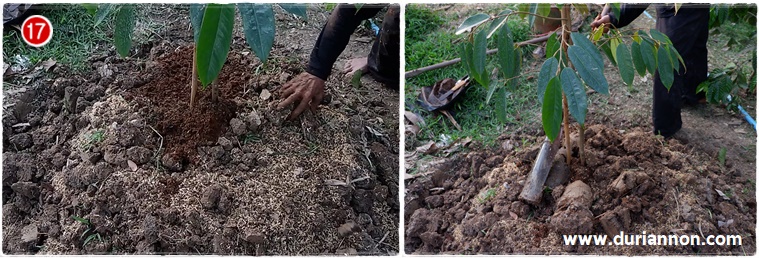Planting durian should be done in the evening to protect the young trees from direct sunlight after planting. Begin by preparing all necessary equipment and ensuring the seedlings are healthy and strong. Follow the correct steps, provide shade, and water the plants after planting. Our Garden has demonstrated these seven steps for everyone to learn.
The durian planting process involves seven key steps:
1) Prepare Equipment: For durian planting, ensure you have the following tools: pruning shears, small knife, twine, hoe, shovel, shade net, straw, wooden stakes slightly taller than the durian saplings, and organic fertilizer. Mix two bags of raw rice husk with one bag of manure and add Trichoderma; let it sit for about 15 days. (Recommended manure: Durian trees have sensitive roots. It's important to understand the characteristics of different manures: pig manure is best because it contains bran and microorganisms; however, ensure it's sterilized and avoid pig manure with lye. For cow manure, be cautious of weeds and worms that may accompany it. For chicken manure, be aware of the heat from sulfur.)



2) Prepare the small trees : Durian saplings can be propagated through methods such as air-layering, grafting, or budding. The scions should be approximately one year old; younger scions may lack strength, while older ones may have coiled roots. Before planting, allow the new leaves to mature or harden off. Planting should not occur while the leaves are still tender, as exposure to intense sunlight can cause immediate wilting. Durian scions can be trained to grow upright or laterally.


3) Create Planting Mounds: In the traditional method, farmers prepare planting mounds by digging up soil from the planting area using a hoe to loosen it, then piling it up to about 50 centimeters above the ground with a diameter of 1 meter. It's beneficial to mix organic fertilizer (a combination of raw rice husk and manure) into the mound soil. After forming the mound, dig a hole in the center to match the size of the seedling's root ball. If organic fertilizer wasn't mixed into the mound, sprinkle it on top and mix it in to encourage the durian roots to seek nutrients. If termites are present, mix one part Puralan with three parts pelletized organic fertilizer and place about a handful at the bottom of the hole before planting.
4) Cut the Nursery Bag and Check for Root Coiling:
After removing the nursery bag (black plastic), it's advisable to remove about one-fifth of the soil from the bottom of the bag. This allows the durian roots to encounter the new soil mixture prepared in the mound. While removing the soil, inspect the taproot. If you find that the taproot is coiled (as shown in Figure 11), it's recommended to trim it. Coiled roots can hinder the durian's growth.In cases where the durian scion has been in the nursery bag for an extended period, the soil may become compacted, leading to coiled taproots. This is normal, and trimming the coiled taproot is acceptable. Durian trees have fibrous roots that emerge from the taproot and specialized "centipede" roots for nutrient absorption. Therefore, cutting the taproot doesn't adversely affect the tree's nutrient uptake.However, if your durian plantation has a high water table—such as in mounded (ridge) planting systems where water is retained in the furrows—it's advisable to trim the taproot, whether it's coiled or not. Untamed taproots may extend into the groundwater, causing the tree to grow tall and spindly. Additionally, a high water table can keep the taproot submerged year-round, potentially leading to root rot.Therefore, if you're using a ridge planting system or have a high water table, it's recommended to trim the taproot, regardless of whether it's coiled. For other planting methods, only trim the taproot if it's coiled. When cutting the root, avoid touching the cut area with your hands to prevent fungal infections.


5) Planting and Supporting the Durian Seedling:
When planting, gently spread the roots outward or arrange them to fan out around the base. This ensures that as the durian tree grows, it develops a balanced root system that extends outward, helping to prevent the tree from toppling.Place the durian seedling in the center of the mound, ensuring the trunk stands upright. Then, insert a stake and tie it with a soft string to protect the young tree from wind sway. Position the stake approximately at the edge of the soil that came with the seedling, being careful not to damage the roots. Tie the string loosely to allow some movement, which helps the tree develop strength.Afterward, cover the base of the tree with soil and use straw mulch around the base to retain moisture.


6) Provide Shade: Durian trees prefer partial shade, especially young ones. Use shade nets or plant temporary shade trees like bananas. In permanent plantations, trees like tamarind can provide shade and additional benefits, such as leaves that can be used as organic matter.
(6.1) Use shade netting: Cut the shade netting to be about 1 foot higher than the durian tree to allow the shadow of the netting to block sunlight for the tree. The netting should cover 3 sides, leaving the side exposed to morning sunlight open to allow for proper air circulation. The top does not need to be covered, as shading the top will only block sunlight during midday and will not protect the tree during the morning and afternoon. Additionally, covering the top will prevent the tree from receiving dew at night. When installing the netting, ensure it is slightly above the ground to allow air to pass through, and avoid placing it too close to the tree, as the netting can retain heat, which may cause leaf burn if it contacts the leaves for extended periods.

(6.2) Planting Shade Trees: Shade trees help provide shade and moisture to durian trees. The best temporary shade plants are bananas, such as the 'Kluai Hom' or 'Kluai Khai' varieties, because they are easy to plant, grow quickly, and provide shade rapidly. For permanent shade trees, in raised bed gardens, it is common to plant 'Thong Lang' trees alternately between durian trees. 'Thong Lang' trees are very beneficial. In addition to providing shade, their fallen leaves can be dug up and used to mulch the base of durian trees, serving as organic matter. During the dry season, the moisture evaporating from 'Thong Lang' leaves helps increase humidity in the air, preventing durian trees from stalling in growth. Furthermore, shade trees can provide additional income for farmers, such as covering garden maintenance costs and durian fertilizer expenses. They also help control weeds, as the shaded garden area reduces weed growth.
7) Watering Durian Trees: After planting, water the trees immediately. During the initial stage, water them every morning consistently, focusing on the area near the base, as the roots have not yet spread far. Various methods can be used for watering, such as using a hose, sprinkler, or mini-sprinkler. However, drip irrigation is not recommended, as it may cause the durian roots to remain concentrated in one spot, preventing them from spreading and potentially leading to fungal growth in areas receiving repeated drips. Additionally, during the early planting stage, avoid using large watering equipment, as it can cause the mound to collapse more quickly and compact the soil, making it difficult for roots to grow. Once the durian trees begin to establish themselves and produce new leaves, it indicates successful planting. For grafted or budded trees, new leaves may appear in about one month, while air-layered trees might take slightly longer, around two months.
After planting, you can learn how to care for newly planted durian trees on the "Caring for Newly Planted Durian Trees" page.



















